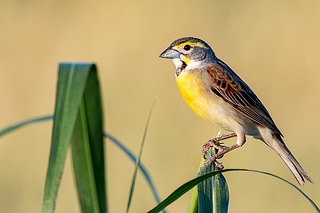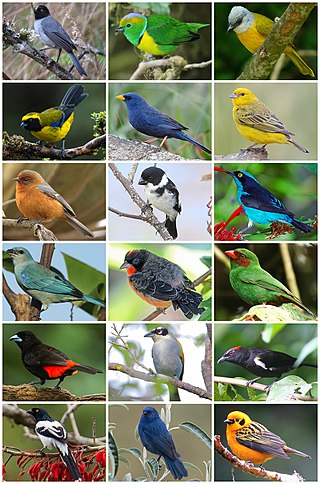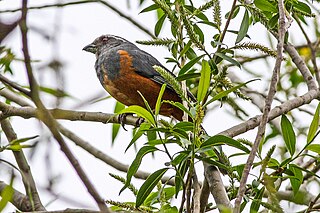
Cardinalidae is a family of New World-endemic passerine birds that consists of cardinals, grosbeaks, and buntings. It also includes several other genera such as the tanager-like Piranga and the warbler-like Granatellus. Membership of this family is not easily defined by a single or even a set of physical characteristics, but instead by molecular work. Among songbirds, they range from average-sized to relatively large, and have stout features, some species with large, heavy bills.

The tanagers comprise the bird family Thraupidae, in the order Passeriformes. The family has a Neotropical distribution and is the second-largest family of birds. It represents about 4% of all avian species and 12% of the Neotropical birds.

Saltator is a genus of passerine birds in the tanager family Thraupidae that are found in Central and South America. They have thick bills, relatively long tails and strong legs and feet. Before the introduction of molecular genetic methods in the 21st century these species were placed in the cardinal family Cardinalidae.

The flame-colored tanager, formerly known as the stripe-backed tanager, is a medium-sized American songbird in the family Cardinalidae, the cardinals or cardinal grosbeaks. It is found from Mexico throughout Central America to northern Panama and occasionally in the United States; four subspecies are recognized. The flame-colored tanager is 18 to 19 cm long, the male having predominantly red-orange while the female is more yellowish orange.

Tangara is a large genus of birds of the tanager family. It includes 27 species. All are from the Neotropics, and while most are fairly widespread, some have small distributions and are threatened. They are fairly small, ranging in size from 11.5–15 centimetres (4.5–5.9 in). This genus includes some of the most spectacularly colored birds of the world.

Haplospiza is a small genus of birds in the tanager family Thraupidae. Formerly classified in the bunting and American sparrow family Emberizidae, more recent studies have shown it to belong in the Thraupidae. Its two members breed in subtropical or tropical moist forest in Central and South America. They are often associated with bamboo.

Emberizoides is a small genus of finch-like tanagers found in grassy areas in Central and South America.

Embernagra is a genus of South American finch-like birds in the tanager family Thraupidae.

The Inca finches form the genus Incaspiza, of finch-like birds in the tanager family Thraupidae. They were traditionally placed in the family Emberizidae, but molecular phylogenetic studies have shown that they belong in Thraupidae instead. Both their scientific and common name refer to the Incan civilization.

Thlypopsis is a genus of birds in the tanager family Thraupidae.

The orange-throated tanager is a species of bird in the tanager family Thraupidae that is found very locally in humid forests around the Ecuador-Peru border. As a species it is considered threatened. The orange-throated tanager is the only member of the genus Wetmorethraupis, named after the ornithologist Alexander Wetmore. It is closely related to members of the genus Bangsia.

The yellow-shouldered grosbeak is a species of bird in the tanager family Thraupidae. It is the only member of its genus Parkerthraustes. It is found in Bolivia, Brazil, Colombia, Ecuador, and Peru. Its natural habitat is subtropical or tropical moist lowland forests.

The rufous-bellied mountain tanager or rufous-bellied saltator is a species of songbird in the tanager family Thraupidae and is the only member of the genus Pseudosaltator. It is found in the eastern Andes of southern Bolivia and extreme northern Argentina. It occurs mostly at altitudes from 3000 m to 4000 m. Its habitat is open land, including cultivated land, that has patches of scrub, alder trees, or Polylepis trees. It is threatened by habitat loss.

Amaurospiza is a genus of seed-eating birds in the cardinal family Cardinalidae that are found in Central and South America.

The plushcap is a species of bird in the tanager family Thraupidae and it is the only member of the genus Catamblyrhynchus.

Chlorospingus is a genus of perching birds, the bush tanagers, traditionally placed in the tanager family (Thraupidae). More recent studies which suggest they are closely related to the genus Arremonops in the Passerellidae. As of July, 2017, the American Ornithological Society assigns the genus to the new family Passerellidae, which contains the New World sparrows.

Carmiol's tanager is a species of bird in the cardinal family Cardinalidae that is found in Central America from Nicaragua southwards to northwest Colombia. Its natural habitats are subtropical or tropical moist lowland forests and heavily degraded former forest. It was formerly considered as conspecific with the yellow-lored tanager.

The red-headed tanager is a medium-sized American songbird in the family Cardinalidae, the cardinals or cardinal grosbeaks, endemic to Mexico. Comprising two subspecies, it is around 15 cm (5.9 in) long. Males have predominantly yellow-olive plumage with a red head and throat and females have yellow forecrowns.

The white-winged tanager is a medium-sized American songbird in the family Cardinalidae, the cardinals or cardinal grosbeaks. It is found from Mexico, through Central America, across northern South America and as far south as Bolivia.

The red-hooded tanager, is a medium-sized American songbird in the family Cardinalidae, the cardinals or cardinal grosbeaks. It is found in Colombia, Ecuador, and Peru.


























